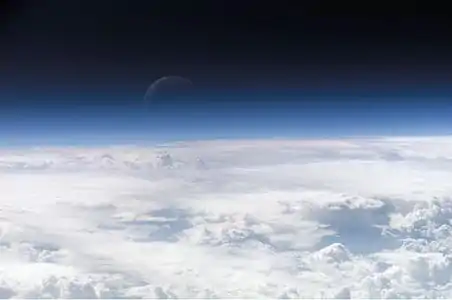Atmosphere of Triton
The atmosphere of Triton is the layer of gases surrounding Triton. The surface pressure is only 14 microbars (1.4 Pa or 0.0105mmHg), 1⁄70000 of the surface pressure on Earth,[1] and it is composed of nitrogen, similar to those of Titan and Earth.[2] It extends 800 kilometers above its surface.[1] Recent observations have shown an increase in temperature.[3]
| Gas | Partial pressure in 1989, μbar |
Partial pressure in 2010, μbar |
|---|---|---|
| N2[4] | 14±1 | 19+1.8 −1.5 or 39±4[5] |
| CH4[6] | (1.6–2.4) × 10−3 | (0.98±0.37)×10−2 |
| CO[6] | ? | 2.4 × 10−2 |
Composition
Nitrogen is the main gas in Triton's atmosphere.[7] The two other known components are methane and carbon monoxide, whose abundances are a few hundredths of a percent of that of the nitrogen. Carbon monoxide, which was discovered only in 2010 by the ground-based observations, is slightly more abundant than methane. The abundance of methane relative to nitrogen increased by four to five times since 1986 due to the seasonal warming observed on Triton, which passed its southern-hemisphere solstice in 2001.[6]
Other possible components of the Triton's atmosphere include argon and neon. Because they were not detected in the ultraviolet part of the spectrum of Triton obtained by Voyager 2 in 1989, their abundances are unlikely to exceed a few percent.[8] In addition to the gases mentioned above, the upper atmosphere contains significant amounts of both molecular and atomic hydrogen, which is produced by the photolysis of methane. This hydrogen quickly escapes into the space serving as a source of plasma in the magnetosphere of Neptune.[8]
Other Solar System planets, dwarf planets, and moons with nitrogen-dominated atmospheres are the Earth, Titan, Pluto and, possibly, Eris.[2]
Structure
Triton's atmosphere is well structured and global.[9] The atmosphere extends up to 800 kilometers above the surface, where the exobase is located, and had a surface pressure of about 14 microbars as of 1989. This is only 1/70,000th of the surface pressure on Earth.[1] The surface temperature was at least 35.6 K (−237.6 °C) because Triton's nitrogen ice is in the warmer, hexagonal crystalline state, and the phase transition between hexagonal and cubic nitrogen ice occurs at that temperature.[10] An upper limit in the low 40s (K) can be set from vapor pressure equilibrium with nitrogen gas in Triton's atmosphere.[11] The most likely temperature was 38±1 K as of 1989. In the 1990s it probably increased by about 1 K, due to the general global warming as Triton approaches the southern-hemisphere summer (see below).[6]
Convection near Triton's surface heated by the Sun creates a troposphere (a "weather region") rising to an altitude of about 8 km. In it temperature decreases with height reaching a minimum of about 36 K at the tropopause.[12] There is no stratosphere, defined as a layer where heating from the warmer troposphere and thermosphere is balanced by radiative cooling.[13] Higher regions include the thermosphere (8–850 km) and exosphere (above 850 km).[14] In the thermosphere the temperature rises reaching a constant value of about 95 K above 300 km.[8] The upper atmosphere continuously leaks into outer space due to the weak gravity of Triton. The loss rate is about 1×1025 nitrogen molecules per second, which equals about 0.3 kg/s.
Weather
Nitrogen ice particles form clouds in the troposphere a few kilometers above the surface of Triton.[1] Above them a haze is present extending up to 30 km from the surface.[15] It is believed to be composed largely of hydrocarbons and nitriles created by the action of the Sun's and stellar ultraviolet light on methane.[13]
In 1989 Voyager 2 discovered that near the surface there are winds blowing to the east or north-east with a speed of about 5–15 m/s.[9] Their direction was determined by observations of dark streaks located over the southern polar cap, which generally extend from the south-west to north-east. These winds are thought to be related to the sublimation of nitrogen ice from the southern cap as there was summer in the southern hemisphere in 1989.[9] The gaseous nitrogen moves northward and is deflected by the Coriolis force to the east forming an anticyclone near the surface. The tropospheric winds are capable of moving material of over a micrometre in size thus forming the streaks.[9]
Eight kilometers high in the atmosphere near the tropopause, the winds change direction.[7] They now flow to the west and are driven by differences in temperature between the poles and equator.[9][12] These high winds may distort Triton's atmosphere making it asymmetric. An asymmetry was actually observed during star occultations by Triton in 1990s.[16]
The atmosphere is dense enough to allow the formation of dunes.[17]
Observations and exploration
Before Voyager 2
Before Voyager 2 arrived, a nitrogen and methane atmosphere with a density as much as 30% that of Earth had been suggested. This proved to be a great overestimate, similar to the predictions of the atmospheric density of Mars, but like on Mars, a denser early atmosphere is postulated.[18]
Voyager 2
Voyager 2 flew past Triton five hours after closest approach to Neptune in mid-late August 1989.[19] During the flyby, Voyager 2 took measurements of the atmosphere,[20] finding methane and nitrogen in the atmosphere.[7]
Later observations
In the 1990s, observations from Earth were made of the occultation of stars by Triton's limb. These observations indicated the presence of a denser atmosphere than was inferred from Voyager 2 data.[21] The surface pressure in the late 1990s is thought to have increased to at least 19 μbar[4] or, possibly, even to 40 μbar.[5] Other observations have shown an increase in temperature by 5% from 1989 to 1998.[3] One of the scientists involved in investigation of Triton, James L. Elliot, said:[3]
"At least since 1989, Triton has been undergoing a period of global warming. Percentage-wise, it's a very large increase."
These observations indicate Triton is having a warm southern-hemisphere summer season, that only happens once every few hundred years, near solstices.[6] Theories for this warming include the sublimation of frost on Triton's surface and a decrease in ice albedo, which would allow more heat to be absorbed.[6][22] Another theory argues the changes in temperature are a result of deposition of dark, red material from geological processes on the moon. Because Triton's Bond albedo is among the highest within the Solar System, it is sensitive to small variations in spectral albedo.[23]
See also
References
- "Triton". Voyager. Archived from the original on 20 December 2007. Retrieved 2007-12-31.
- "Neptune: Moons: Triton". Solar System Exploration. Archived from the original on 10 January 2008. Retrieved 2007-12-31.
- "MIT researcher finds evidence of global warming on Neptune's largest moon". Massachusetts Institute of Technology. 1998-06-24. Archived from the original on 17 December 2007. Retrieved 2007-12-31.
- Elliot, J.L.; Strobel, D.F.; Zhu, X.; et al. (2000). "The Thermal Structure of Triton's Middle Atmosphere" (PDF). Icarus. 143 (2): 425–428. Bibcode:2000Icar..143..425E. doi:10.1006/icar.1999.6312.
- Elliot, J.L.; Hammel, H.B.; Wasserman, L.H.; et al. (1998). "Global warming on Triton" (PDF). Nature. 393 (6687): 765–767. Bibcode:1998Natur.393..765E. doi:10.1038/31651.
- Lellouch, E.; de Bergh, C.; Sicardy, B.; et al. (2010). "Detection of CO in Triton's atmosphere and the nature of surface-atmosphere interactions". Astronomy and Astrophysics. 512: L8. arXiv:1003.2866. Bibcode:2010A&A...512L...8L. doi:10.1051/0004-6361/201014339.
- Miller, Ron; William K. Hartmann (May 2005). The Grand Tour: A Traveler's Guide to the Solar System (3rd ed.). Thailand: Workman Publishing. pp. 172–173. ISBN 0-7611-3547-2.
- Broadfoot, A.L.; Atreya, S.K.; Bertaux, J.L.; et al. (1999). "Ultraviolet Spectrometer Observations of Neptune and Triton" (PDF). Science. 246 (4936): 1459–1466. Bibcode:1989Sci...246.1459B. doi:10.1126/science.246.4936.1459. PMID 17756000.
- Ingersoll, Andrew P. (1990). "Dynamics of Triton's atmosphere". Nature. 344 (6264): 315–317. Bibcode:1990Natur.344..315I. doi:10.1038/344315a0.
- N S Duxbury; R H Brown (August 1993). "The Phase Composition of Triton's Polar Caps". Science. 261 (5122): 748–751. Bibcode:1993Sci...261..748D. doi:10.1126/science.261.5122.748. ISSN 0036-8075. PMID 17757213.
- Kimberly Tryka; Robert Brown; V. Anicich; et al. (August 1993). "Spectroscopic Determination of the Phase Composition and Temperature of Nitrogen Ice on Triton". Science. 261 (5122): 751–754. Bibcode:1993Sci...261..751T. doi:10.1126/science.261.5122.751. ISSN 0036-8075. PMID 17757214.
- Smith, B.A.; Soderblom, L.A.; Banfield, D.; et al. (1989). "Voyager 2 at Neptune: Imaging Science Results". Science. 246 (4936): 1422–1449. Bibcode:1989Sci...246.1422S. doi:10.1126/science.246.4936.1422. PMID 17755997.
- McKinnon, William B.; Randolph L. Kirk (2007) [2007]. "Triton". Encyclopedia of the Solar System (2nd. ed.). Academic Press. pp. 483–502. ISBN 978-0-12-088589-3.
- Lellouch, E.; Blanc, M.; Oukbir J. & Longaretti, P.-Y. (1992). "A model of Triton's atmosphere and ionosphere". Advances in Space Research. 12 (11): 113–121. Bibcode:1992AdSpR..12..113L. doi:10.1016/0273-1177(92)90427-Y.
- "Triton". nineplanets.org. Archived from the original on 17 December 2007. Retrieved 2007-12-31.
- Elliot, J.L.; Stansberry, J.A.; Olkin, C.B.; et al. (1997). "Triton's Distorted Atmosphere". Science. 278 (5337): 436–439. Bibcode:1997Sci...278..436E. doi:10.1126/science.278.5337.436. PMID 9334297.
- Wondrous dunes on Pluto are made of grains of frozen methane
- Lunine, J. I. & Nolan, Michael C. (1992). "A massive early atmosphere on Triton". Icarus. 100 (1): 221–234. Bibcode:1992Icar..100..221L. doi:10.1016/0019-1035(92)90031-2.
- Wilford, John (1989-08-22). "Profile of Neptune's Main Moon: Small, Bright, Cold, and It's Pink". The New York Times. Archived from the original on 10 January 2008. Retrieved 2007-12-31.
- "Triton: Background and Science". Planetary Science Directorate, Boulder Office. Archived from the original on 19 January 2008. Retrieved 2007-12-31.
- Savage, D.; Weaver, D. & Halber, D. "Hubble Space Telescope Helps Find Evidence that Neptune's Largest Moon Is Warming Up". Hubblesite. Archived from the original on May 16, 2008. Retrieved 2007-12-31.
- "Global Warming Detected on Triton". Scienceagogo.com. 1998-05-28. Archived from the original on 14 December 2007. Retrieved 2007-12-31.
- Buratti, Bonnie J.; Hicks, Michael D.; Newburn Jr., Ray L. (1999). "Does global warming make Triton blush?" (PDF). Nature. 397 (6716): 219–20. Bibcode:1999Natur.397..219B. doi:10.1038/16615. PMID 9930696. Archived from the original (PDF) on 2007-06-11.
- "About the Triton Watch Project". Planetary Science Directorate, Boulder Office. Archived from the original on 19 January 2008. Retrieved 2007-12-31.


